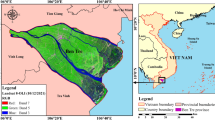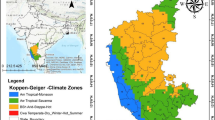Abstract
The application of remote sensing monitoring techniques plays a crucial role in evaluating and governing the vast amount of ecological construction projects in China. However, extracting information of ecological engineering target through high-resolution satellite image is arduous due to the unique topography and complicated spatial pattern on the Loess Plateau of China. As a result, enhancing classification accuracy is a huge challenge to high-resolution image processing techniques. Image processing techniques have a definitive effect on image properties and the selection of different parameters may change the final classification accuracy during post-classification processing. The common method of eliminating noise and smoothing image is majority filtering. However, the filter function may modify the original classified image and the final accuracy. The aim of this study is to develop an efficient and accurate post-processing technique for acquiring information of soil and water conservation engineering, on the Loess Plateau of China, using SPOT image with 2.5 m resolution. We argue that it is vital to optimize satellite image filtering parameters for special areas and purposes, which focus on monitoring ecological construction projects. We want to know how image filtering influences final classified results and which filtering kernel is optimum. The study design used a series of window sizes to filter the original classified image, and then assess the accuracy of each output map and image quality. We measured the relationship between filtering window size and classification accuracy, and optimized the post-processing techniques of SPOT5 satellite images. We conclude that (1) smoothing with the majority filter is sensitive to the information accuracy of soil and water conservation engineering, and (2) for SPOT5 2.5 m image, the 5×5 pixel majority filter is most suitable kernel for extracting information of ecological construction sites in the Loess Plateau of China.
Similar content being viewed by others
References
Fu B J, Chen L D, Ma K M, et al. The relationships between land use and soil conditions in the hilly area of the loess plateau in northern Shaanxi, China. Catena, 2000, 39: 69–78
Chen L D, Wang J, Fu B J, et al. Land-use change in a small catchments of northern Loess Plateau, China. Agric Ecos Environ, 2001, 86: 163–172
Wu B. Countermeasures and its evaluation on soil and water conservation in the Loess Plateau, China. Report on World Conference on Disaster reduction. 18–22 January 2005, Kobe, Hyogo, Japan. 2005
Qiao Y L, Wang Y, Tang J Y. Study of remote sensing monitoring of dynamic change of the Loess Plateau forest resources. Adv Space Res, 2004, 33: 302–306
Stolte J, Ritsema C J, Bouma J. Developing interactive land use scenarios on the Loess Plateau in China, presenting risk analyses and economic impacts. Agric Ecos Environ, 2004, 105: 387–399
Li W H. Degradation and restoration of forest ecosystems in China. For Ecol Manage, 2004, 201: 33–41
Xu X Z, Zhong H W, Zhang O Y. Development of check-dam systems in gullies on the Loess Plateau, China. Environ Sci Policy, 2004, 7: 79–86
Shi W Z, Zhu C Q, Tian Y, et al. Wavelet-based image fusion and quality assessment. Int J Appl Earth Obser Geo-infor, 2005, 6: 241–251
Barr S, Barnsley M. Reducing structural clutter in land cover classifications of high spatial resolution remotely-sensed images for urban land use mapping. Comput Geosci, 2000, 26: 433–449
Pradhan S. Regional land cover mapping of the Hindu Kush Himalayan (HKH) Region: an approach to understand the dynamics of land use and land cover change using satellite image. Available on line: http://www.gisdevelopment.net//, 2002
Syphard A D, Franklin J. Spatial aggregation effects on the simulation of landscape pattern and ecological processes in southern California plant communities. Ecol Model, 2004, 180: 21–40
Huang M B, Shao M G, Zhang L, et al. Water use efficiency and sustainability of different long-term crop rotation systems in the Loess Plateau of China. Soil Tillage Res, 2003, 72: 95–104
Pasqualini V, Martini C P, Pergent G, et al. Use of SPOT5 for mapping seagrasses: An application to Posidonia oceanica. Remote Sens Environ, 2005, 94: 39–45
ERDAS Inc. ERDAS Imagine Field Guide. Atlanta, GA. 1995.
Prenzel B, Treitz P. Remote sensing change detection for a watershed in north Sulawesi, Indonesia. Prog Planning, 2004, 61: 349–363
Congalton R. A review of assessing the accuracy of classifications of remotely sensed data. Remote Sens Environ, 1991, 37: 35–46
Niel T G V, McVicar T R. Current and potential uses of optical remote sensing in rice-based irrigation systems: a review, Australian. J Agric Res, 2004, 55: 155–185
Moody A, Woodcock C E. The influence of scale and the spatial characteristics of landscapes on land-cover mapping using remote sensing. Landsc Ecol, 1995, 6: 363–379
Raptisa V S, Vaughana R A, Wrightb G G. The effect of scaling on landcover classification from satellite data. Comput Geosci, 2003, 29: 705–714
Tang G A, Zhang Y S, Liu Y M, et al. Remote Sensing Digital Image Processing (in Chinese). Beijing: Science Press, 2004. 232–233
Zhang J Y, Lu Z J, Shi L, et al. Filtering images contaminated with pep and salt type noise with pulse-coupled neural networks. Sci China Ser F-Inf Sci, 2005, 48(3): 322–334
Author information
Authors and Affiliations
Corresponding author
Rights and permissions
About this article
Cite this article
Dong, R., Dong, J., Wu, G. et al. Optimization of post-classification processing of high-resolution satellite image: A case study. SCI CHINA SER E 49 (Suppl 1), 98–107 (2006). https://doi.org/10.1007/s11431-006-8111-3
Received:
Accepted:
Issue Date:
DOI: https://doi.org/10.1007/s11431-006-8111-3




